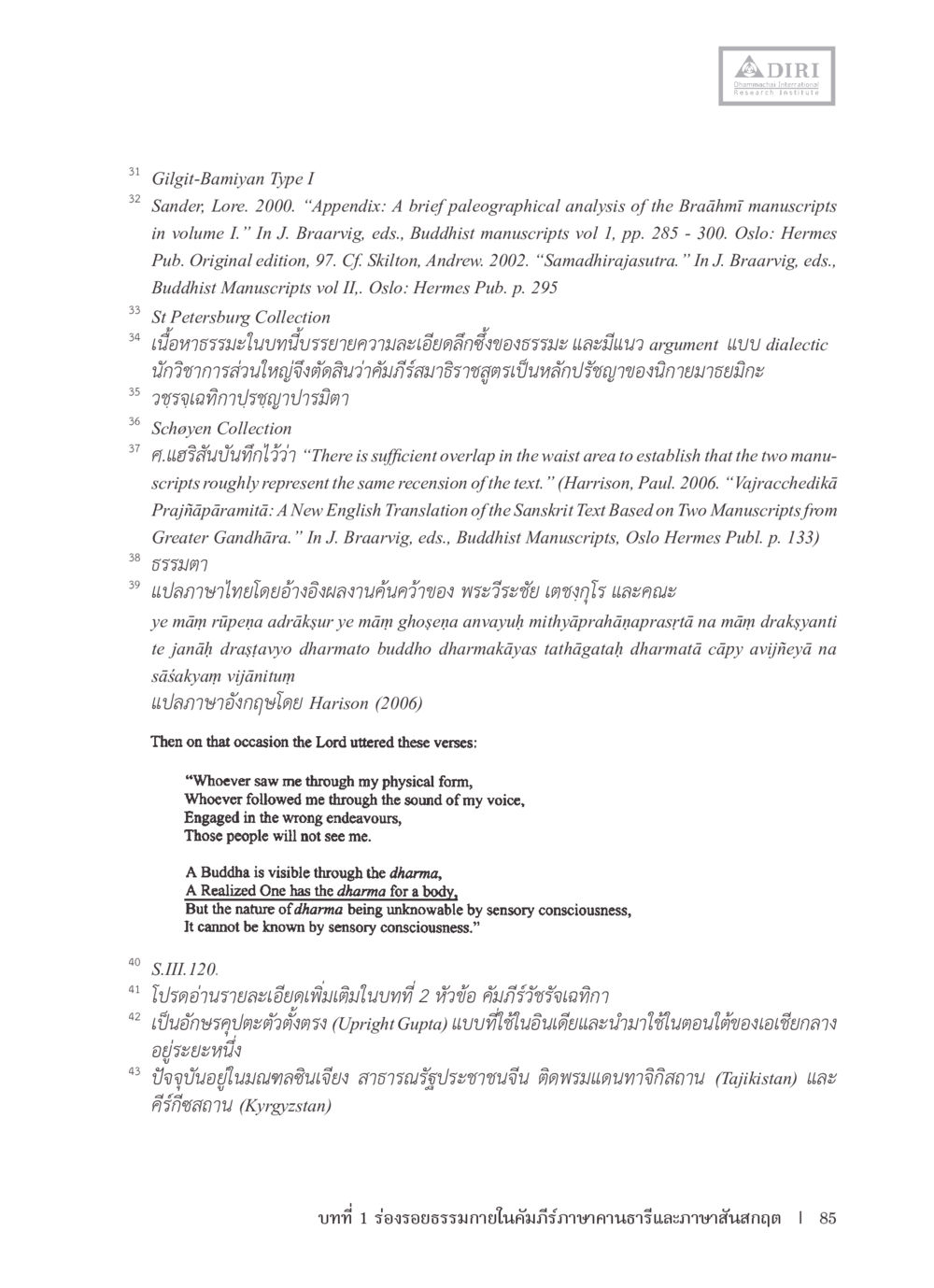การวิเคราะห์พาลีกราฟและคัมภีร์มนต์ในพระพุทธศาสนา : หน้า 86/374
หลักฐานธรรมกายในคัมภีร์พุทธโบราณ 1 ฉบับรวมงานวิจัยโดยย่อ : หน้า 86/374 การวิเคราะห์และศึกษาเกี่ยวกับคัมภีร์ในพระพุทธศาสนาที่มีภูมิหลังสำคัญกับปรัชญาและโครงสร้างของธรรมะ
3 ครั้ง

สรุปเนื้อหา
บทนี้นำเสนอการวิเคราะห์พาลีกราฟในคัมภีร์ Braḥmī และการศึกษาภาษาไทยของบทพระธรรมที่สำคัญ รวมถึงคำแปลของคำสอนจากพระพุทธเจ้าและปรัชญาเกี่ยวกับธรรมะจากแหล่งที่มาแตกต่างกัน แสดงให้เห็นถึงคุณค่าทางวัฒนธรรมและปรัชญาที่ข้ามเวลาและสถานที่ โดยงานวิจัยรวมถึงผลงานจากนักวิชาการหลายท่าน เช่น สันเดอร์และแฮร์ริสัน บทความนี้เน้นถึงความสำคัญในการเข้าใจธรรมะและการแสดงออกทางปัญญาที่เกี่ยวข้องกับศาสนาและการศึกษาไทยยุคใหม่ โปรดอ่านรายละเอียดเพิ่มเติมในหน้า 2 หัวข้อ คำมีวิรัชรฉันท์กก
หัวข้อประเด็น
-การวิเคราะห์พาลีกราฟ
-คัมภีร์ทางพระพุทธศาสนา
-ปรัชญาในธรรมะ
-การแปลภาษาและความหมาย
-ภูมิหลังของธรรมะในเอเชียกลาง
ข้อความต้นฉบับในหน้า
Gilgit-Bamiyan Type I
Sander, Lore. 2000. “Appendix: A brief paleographical analysis of the Braḥmī manuscripts
in volume I.” In J. Braarvig, eds., Buddhist manuscripts vol 1. pp. 285 - 300. Oslo: Hermes Pub. Original edition, 97. Cf. Skilton, Andrew. 2002. “Samadhijasustra.” In J. Braarvig, eds., Buddhist Manuscripts vol II., Oslo: Hermes Pub. p. 295
St Petersburg Collection
เนื้อหาธรรมในบทนี้บรรยายความละเอียดลออของธรรมะ และแนว argument แบบ dialectic นักวิชาการส่วนใหญ่มักตัดสินว่ายคมณ์ภิรัษม์เป็นหลักปรัชญาของนายมาริมิกะ
วจรจ์เฉพาะการปรุงยาบาปมิฏตา
Schoyen Collection
ค.แสลัสนิยามไว้ว่า "There is sufficient overlap in the waist area to establish that the two manuscripts roughly represent the same recension of the text." (Harrison, Paul. 2006. “Vajracchedikā Prajñāpāramitā: A New English Translation of the Sanskrit Text Based on Two Manuscripts from Greater Gandhāra.” In J. Braarvig, eds., Buddhist Manuscripts, Oslo Hermes Publ. p. 133)
ธรรมฏา
แปลภาษไทยโดยอ้างอิงผลงานคัมภีร์ของ พระวิรัชย์ เดชกุโล และคณะ
เว มารํ รุเพนา อัครัสกุร เว มํ โกษณา อนวุฒิ มථยประชานปริสตา na มำํ draksYanti te janah drasTyavo dharmato buddho dharmakāyas tathāgataḥ dharmatā ca vyajne ya na sashakyam vijanitum
แปลภาษอังกฤษโดย Harrison (2006)
Then on that occasion the Lord uttered these verses:
“Whoever saw me through my physical form,
Whoever followed me through the sound of my voice,
Engaged in the wrong endeavours,
Those people will not see me.
A Buddha is visible through the dharma,
A Realized One has the dharma for a body,
But the nature of dharma being unknowable by sensory consciousness,
It cannot be known by sensory consciousness.”
S.III.120.
โปรดอ่านรายละเอียดเพิ่มเติมในหน้า 2 หัวข้อ คำมีวิรัชรฉันท์กก
เป็นอักษรครูตะตัวตรง (Upright Gupta) แบบที่ใช้ในอินเดียและนำมาใช้ในตอนใต้ของเอเชียกลาง
ปัจจุบันอยู่ในดนตสันเวียง สาราณัฐรัฐประชาชน จีน ติดพม่าแดนทาจิกิสถาน (Tajikistan) และ คีร์กีสถาน (Kyrgyzstan)
Tags : #พุทธศาสนา #คัมภีร์ #ธรรมะ #พาลีกราฟ #ปรัชญา
หน้าหนังสือทั้งหมด

1

2

3

4

5

6

7

8

9

10

11

12

13

14

15

16

17

18

19

20

21

22

23

24

25

26

27

28

29

30

31

32

33

34

35

36

37

38

39

40

41

42

43

44

45

46

47

48

49

50

51

52

53

54

55

56

57

58

59

60

61

62

63

64

65

66

67

68

69

70

71

72

73

74

75

76

77

78

79

80

81

82

83

84

85

86

87

88

89

90

91

92

93

94

95

96

97

98

99

100

101

102

103

104

105

106

107

108

109

110

111

112

113

114

115

116

117

118

119

120

121

122

123

124

125

126

127

128

129

130

131

132

133

134

135

136

137

138

139

140

141

142

143

144

145

146

147

148

149

150

151

152

153

154

155

156

157

158

159

160

161

162

163

164

165

166

167

168

169

170

171

172

173

174

175

176

177

178

179

180

181

182

183

184

185

186

187

188

189

190

191

192

193

194

195

196

197

198

199

200

201

202

203

204

205

206

207

208

209

210

211

212

213

214

215

216

217

218

219

220

221

222

223

224

225

226

227

228

229

230

231

232

233

234

235

236

237

238

239

240

241

242

243

244

245

246

247

248

249

250

251

252

253

254

255

256

257

258

259

260

261

262

263

264

265

266

267

268

269

270

271

272

273

274

275

276

277

278

279

280

281

282

283

284

285

286

287

288

289

290

291

292

293

294

295

296

297

298

299

300

301

302

303

304

305

306

307

308

309

310

311

312

313

314

315

316

317

318

319

320

321

322

323

324

325

326

327

328

329

330

331

332

333

334

335

336

337

338

339

340

341

342

343

344

345

346

347

348

349

350

351

352

353

354

355

356

357

358

359

360

361

362

363

364

365

366

367

368

369

370

371

372

373

374
หนังสือที่เกี่ยวข้อง
Load More
